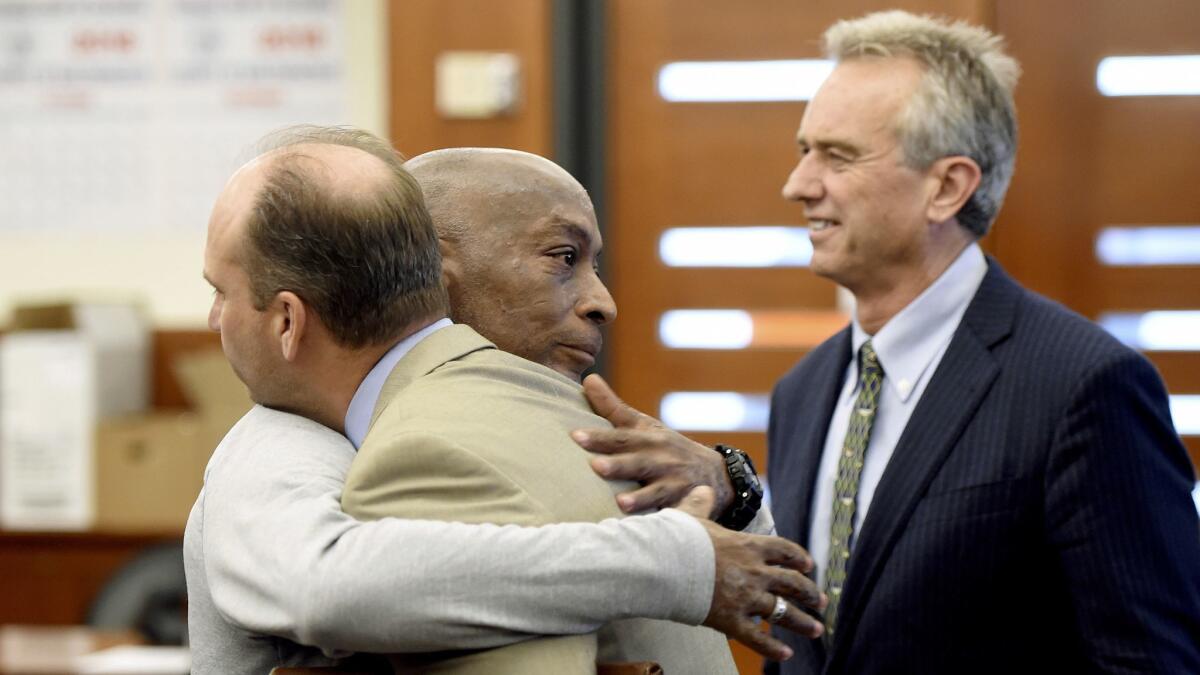Column: Monsanto’s ethics are questionable, but the $289-million verdict against it is still unjustified

- Share via
At the outset, let’s stipulate — as the lawyers might say — that the chemical giant Monsanto is not well cast as a victim.
The company has spent an average of almost $6 million a year since 2010 on lobbying in Washington. It has insinuated itself deeply into deliberations at the Environmental Protection Agency over the safety of its products, and its executives smear scientists who raise questions about those products. The company has been accused of ghost-writing scientific reports so they hew to the company line. Internal documents unsealed by a judge show Monsanto taking strong steps to massage data to portray one of its key products, the weed killer glyphosate, as safe for human use.
That’s become relevant to the question of whether glyphosate or its blockbuster formulation, Roundup, causes cancer in humans — or more specifically, whether it caused the non-Hodgkin’s lymphoma, a blood cancer, that is killing DeWayne Johnson. He’s the 46-year-old Vallejo groundskeeper who won a $289-million verdict against Monsanto on Friday, when a San Francisco County Superior Court jury found that the company knowingly marketed a dangerous chemical and kept the facts from the public and from Johnson, who used a glyphosate formulation called Ranger Pro on the job.
It’s unfortunate that junk science and this kind of mischief creates so much confusion for consumers.
— Former Monsanto CEO Hugh M. Grant
The verdict looks like a boon for thousands of similar lawsuits already filed across the country, including more than 400 in federal court. The award was a crushing blow for the German company Bayer, which closed its purchase of Monsanto for $60 billion only two months ago. Bayer shares have lost more than 17% in the few days since the verdict was issued.
But there’s another sense in which the verdict is bad news: It’s a sign that juries are unable to weigh scientific evidence in cases where that evidence is key.
On the surface, the Johnson jury found that glyphosate more likely than not contributed to Johnson’s cancer. But that’s a questionable conclusion, for the simple reason that the scientific evidence that glyphosate can cause cancer, especially lymphatic cancer, is sketchy at best — and, according to one huge study of herbicide use in the U.S., nonexistent. Medical science doesn’t actually know what causes non-Hodgkin’s lymphoma, which means that tying it to glyphosate could hardly be a scientific judgment.
Johnson deserves some succor for his terminal illness. The issue is whether Monsanto is the right source. A $289-million verdict might be justified if the evidence showed that Monsanto was directly responsible for Johnson’s sickness. The evidence didn’t come close to showing that.
One can applaud a judicial system that delivers redress to a sick patient. But this case demonstrates the profound flaws of a system that can deliver a sizable hit on a corporation despite the lack of hard evidence. It’s not unusual for the scientific evidence in a product liability case, especially one focused on a disease cause, to be equivocal. But the legal system isn’t oriented to equivocal outcomes — a defendant is either guilty or not guilty, responsible or not.
That might not matter when the question is whether a plaintiff got run over by a defendant driving a car. But pinpointing one culprit is virtually impossible when a disease could have untold possible causes.
Epidemiological studies like those at the heart of the Johnson lawsuit can be as much art as science, says Richard G. Stevens, a medical professor at the University of Connecticut who followed the case. “It’s easy to do it badly, and a bad study is worse than no study at all.”
If the Johnson verdict stands, that isn’t good for the credibility of the system. And it’s not good for anyone who depends on the system’s credibility, which includes almost everyone.
It’s also not good for the farmers who use glyphosate, which has become the leading weed killer in the world since Monsanto introduced it in the 1970s. The product is popular for several reasons — it’s considered less toxic than the herbicides it has displaced, and the crops on which it’s most commonly used have been genetically modified (by Monsanto, their marketer) to resist it.
With that in mind, let’s look at the scientific record on glyphosate and see how it’s getting weighed in court.
Epidemiological studies of the causes of disease fall into two major categories. Case-control studies take a group of people with a given condition and check for their past exposure to a chemical or other possible cause, comparing it with a control group of subjects that have not developed the condition. Cohort studies start with a population, separate them into exposed and non-exposed groups, and track them over time to see what develops.
Case-control studies are cheaper but generally less reliable because disease sufferers tend to think back to their possible exposures and may overstate them.
With glyphosate, the studies suggesting it’s linked to cancer are chiefly case-control studies. On the other side is the Agricultural Health Study, a federally financed cohort study that has kept an eye on 57,000 pesticide users in Iowa and North Carolina since the 1990s. The study, according to the most recent analysis, has found “no statistically significant associations with glyphosate use and cancer.”
Unsurprisingly, plaintiffs and their experts think very highly of the case-control studies and try to knock down the Agricultural Health Study. Monsanto takes the opposite view.
There’s one other wrinkle. In 2015, the International Agency for Research on Cancer, a unit of the World Health Organization, designated glyphosate as “probably carcinogenic to humans.” That sounds bad, but it’s not quite as definitive as it sounds. According to IARC classifications, it means that the evidence that it causes cancer in humans is “limited” and that explanations including “chance, bias or confounding [meaning an unrelated factor] could not be ruled out,” but that some evidence also exists from animal experiments.
Plaintiffs suing Monsanto typically depict the IARC paper as tantamount to proof that glyphosate causes cancer. But that’s not how it’s viewed by Vince Chhabria, the federal judge overseeing the more than 400 Monsanto lawsuits in federal courts.
In a pretrial ruling in July, Chhabria observed that IARC doesn’t intend the term “probably” to have “any quantitative significance.” He warned that any plaintiff expert relying on IARC alone to make the case that glyphosate causes cancer would be unlikely to be admitted to testify in his courtroom. Chhabria also said the evidence of a connection between glyphosate and lymphoma “seems rather weak,” to the extent that he questioned the credibility of experts who have “confidently identified a causal link.”
The history of the IARC paper does point to the lengths to which Monsanto has gone to protect its star product. Monsanto was openly furious about the paper. “It’s unfortunate that junk science and this kind of mischief creates so much confusion for consumers,” then-company CEO Hugh M. Grant said on a conference call with investment analysts a few weeks after it appeared.
This was a crass and stupid remark, which Monsanto has been unable to live down. The IARC paper was not junk science, but a painstakingly developed finding by a panel of qualified scientists. Nevertheless, an army of corporate henchmen mobilized in Washington to pick it apart. In a letter to IARC Director Christopher Wild, for instance, Reps. Lamar Smith (R-Texas) and Andy Biggs (R-Ariz.), two of the leading science deniers in the House, accused IARC of manipulating data to reach its conclusions. Wild slapped them down.
Given the dearth of firm scientific evidence of glyphosate’s role in DeWayne Johnson’s illness, his case turned more on whether Monsanto should have posted warning labels on its glyphosate products. Although Judge Suzanne Bolanos instructed the jury that a big corporation is “entitled to the same fair and impartial treatment that you would give to an individual,” one of the jobs of plaintiff attorneys is to paint the picture of a lone cancer patient battling a soulless behemoth — just as it’s the defense’s job to offer an alternative. (For a vivid and entertaining day-by-day account of the theater in the courtroom, we recommend a blog by Kelly Ryerson, a former investment banker and unapologetic critic of Monsanto, writing under the pseudonym “Glyphosate Girl.”)
In his closing argument Aug. 7, R. Brent Wisner, Johnson’s attorney, made much of the fact that Monsanto didn’t call Johnson back when he phoned to inquire about the hazard of the product he was using. Wisner urged the jury to issue a verdict “that says, ‘Monsanto, no more. Warn. Call people back.’...If you return a verdict that does that, that actually changes the world.”
As for the science, he pointed to the “preponderance of evidence” standard in a civil trial—if the jury weighed both sides and thought there was even a feather’s weight more on Johnson’s, that was enough. “What we have to prove to you is not, yes, absolutely, it causes cancer.” If the jurors could conclude, “’I’m not so sure, but I think so,’” he said, “we’ve met our burden.”
Against this reality, Monsanto’s defense couldn’t help but seem a little wan. Monsanto lawyer George Lombardi said in his summation that the case was simply “about whether Mr. Johnson’s cancer was caused by Ranger Pro. The evidence is clear” that it was not. “It’s not my burden to show you that,” he said. “It’s the plaintiff’s burden.”
If this were an Olympic skating competition, Lombardi would get laughed off the ice on artistic merit alone. The jury awarded Johnson $39.2 million in straight damages, and $250 million in punitive damages.
This is the right outcome within the limits of the court system. But is it the right outcome in a scientific debate? That’s doubtful. The problem is that alternatives are hard to identify. Bringing these cases before specialized tribunals or setting up public funds for victims of certain products all have their own flaws.
The jury trial “is a highly imperfect process,” says UConn’s Stevens. “But like democracy, it’s the best we have.”
Keep up to date with Michael Hiltzik. Follow @hiltzikm on Twitter, see his Facebook page, or email [email protected].
Return to Michael Hiltzik’s blog.
UPDATES:
11:24 a.m., Aug. 19: This post has been updated to clarify the procedures utilized in case-control studies.
More to Read
Inside the business of entertainment
The Wide Shot brings you news, analysis and insights on everything from streaming wars to production — and what it all means for the future.
You may occasionally receive promotional content from the Los Angeles Times.











